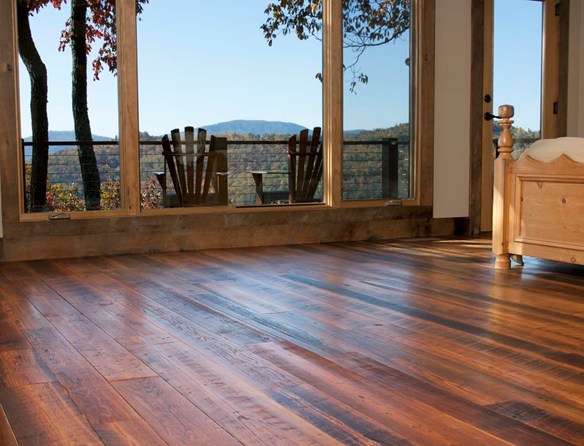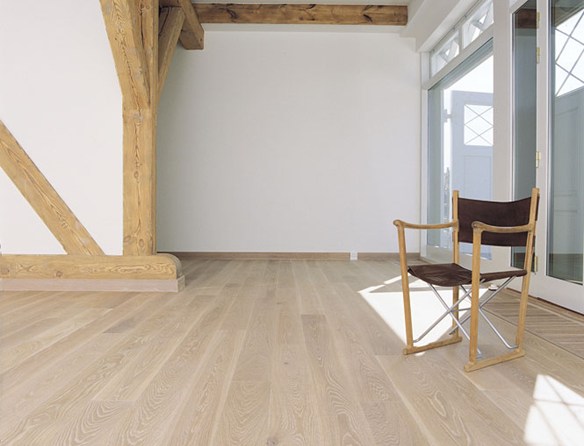Natural Oil Finishes
Until a few years ago, most wood floors in America were finished with fairly high levels of gloss with waxes and urethane top coating systems. As wood floor customers have come to desire more of a natural look on their floors that complement the natural beauty of wood, gloss levels have been reduced to satin or even matte look. With the advent of older looking floors, such as scraped or antiqued floors, less gloss has become even more important in an attempt to achieve a natural, “old world” look.
An oil finished floor provides the most natural look of any wood floor finish. Prior to the use of various urethane and similar finishes, oil was the traditional finish of choice. In Europe, where this traditional natural look has been in demand for quite some time, oil finishes account for almost a third of all wood floor finishes. Since an oil finish actually penetrates and becomes a part of the surface of a wood floor, it is not nearly as sensitive to scratches or wears as a urethane finish. It provides very good protection, is easy to maintain and, if done properly, will prevent a wood floor from ever having to be sanded.
European style oils are also different from non-hardening oils, as they contain very high amounts of solid particles, as high as 91%. This translates into a very high-quality floor finish that is very friendly to our environment.
Environmental Impact of Oil finishes
- Oil finishing products are truly enabling consumers to make an environmentally friendly choice while ensuring that their wood floors look beautiful and are well protected.
- Positive influence on the working area and living environment. Improvement of product characteristics and application methods. No effect on indoor air quality.
- These products are a plant-based non-emitting finish, which complies with South Coast Air Quality Management standards and always qualifies for LEED credits
- Oil Finish is environmentally responsible, sustainable, nonpolluting, durable wood finish, with no artificial color pigments or preservatives.
- Natural Oil finishes are VOC free
What is VOC?
 VOC is short for Volatile Organic Compounds. These are organic compounds with high enough vapor pressure under normal conditions to significantly vaporize and enter the atmosphere. The most common VOC is methane but artificial VOCs include paint thinners, dry cleaning solvents, and gasoline. As these products are being used or when components oxidize, vapors of VOCs escape into the ambient air and contribute to indoor and outdoor air pollution. Many VOCs, especially methane, are greenhouse gases and contribute to global warming. The Environmental Protection Agency has found concentrations of VOCs in indoor air to be 2 to 5 times greater than in outdoor air.
VOC is short for Volatile Organic Compounds. These are organic compounds with high enough vapor pressure under normal conditions to significantly vaporize and enter the atmosphere. The most common VOC is methane but artificial VOCs include paint thinners, dry cleaning solvents, and gasoline. As these products are being used or when components oxidize, vapors of VOCs escape into the ambient air and contribute to indoor and outdoor air pollution. Many VOCs, especially methane, are greenhouse gases and contribute to global warming. The Environmental Protection Agency has found concentrations of VOCs in indoor air to be 2 to 5 times greater than in outdoor air.
Realizing a need to reverse the negative environmental impact of many VOCs, local, regional and state governments in many countries have, during the past several years, put in place ever more stringent regulations limiting VOC emissions. In the US, California has been on the forefront requiring significantly lower levels of VOC in many products.
Easy install and repair
 The European style oil finish will both penetrate into the surface of the wood floor and, as they cure, harden to form a very protective surface, which is easily applied and maintained. This means that normal wear and tear, such as small scratches and indentations, do not show up as much as on a floor with a urethane finish.
The European style oil finish will both penetrate into the surface of the wood floor and, as they cure, harden to form a very protective surface, which is easily applied and maintained. This means that normal wear and tear, such as small scratches and indentations, do not show up as much as on a floor with a urethane finish.
This type of oil finish has been manufactured in Europe for over 30 years. They are primarily manufactured from cold-pressed vegetable oils and aromatic hardening oils. Wood that is used indoors is subjected to wear and tear and needs protection that won’t impair the natural properties of the wood. It must be allowed to “breathe” so that it retains its elasticity and has a positive effect on room climate. Oil finishes will allow the wood floor to breathe through its surface.
Normal cleaning is easy by using the oil manufacturer’s soap, simply mixing it with warm water and mopping the floor periodically. As the floor is being cleaned, it is also given added protection against wear and tear. The soap can contain soy and coconut fats, which dry like an invisible film on the surface of the floor and give it added protection. Periodic cleaning and maintenance will make it unnecessary to ever screen or sand your wood floor.
Once an Oil interior finish has been applied, the wood retains its natural appearance and feel. The surface will become hard-wearing, non-abrasive, water-repellent, and dirt-resistant. It will be protected against everyday accidents of water, wine, beer, cola, sodas, etc., should any minor damages occur, surfaces can easily be touched up with no visible brush marks. Unlike urethane, which must have the entire floor sanded down to repair, oil finishes can be spot repaired quickly and easily.
With the right care and attention, Oil coated wood will keep its natural beauty for decades.



